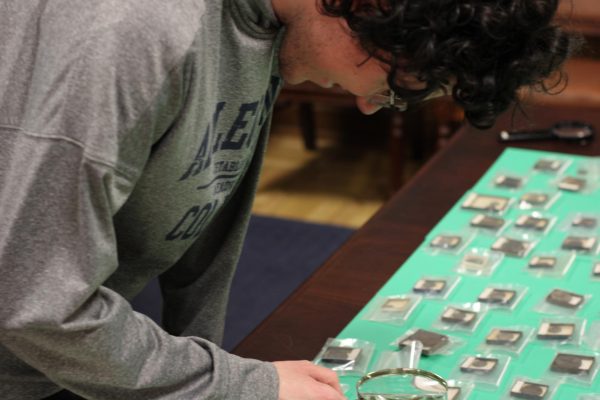Cole launches strategic planning initiative
On the afternoon of Friday, March 24, Allegheny College President Ron Cole, ’87, stood in Shafer Auditorium and invoked the old tree that stands at the southwest corner of Bentley Hall.
“So stands the sycamore, so stands Allegheny,” he told the assembled faculty and staff. “That sycamore, and Allegheny, have withstood the test of time and will continue to do so.”
Cole was on stage for a State of the College address, part of the slow launch of a larger strategic planning process that comes at what Cole says is a “pivotal moment” for the college.
“This strategic process is about charting a pathway for Allegheny into the 21st century,” he said in an interview last week. “It’s about understanding Allegheny College’s mission, understanding the students that we serve today and understanding the students that we can serve in the years ahead.”
The process — announced to students in a March 29 email that called for student volunteers — is focused on three broad areas. “Programs” refers to Allegheny’s curricular and cocurricular offerings; “People” will handle the student and employee experience; and “Places” will examine the college’s physical infrastructure, buildings and grounds, and partnerships with Meadville. All of these focus areas Cole likened to a Venn diagram converging back on one idea.
“I believe everything that we do at Allegheny College needs to intersect the student experience in a positive way,” he said. “If it doesn’t, we have to ask why we’re doing it.”
This re-evaluation of the college comes as a well-documented “demographic cliff” looms for higher education. Vox called it “the incredible shrinking future of college” and cited a declining birth rate after the Great Recession as the cause.
On stage, Cole stood in front of a map of the United States color-coded for projected numbers of high school graduates. A red blotch from Maine to Arkansas and the Dakotas forecasted fewer incoming college students for Pennsylvania and its neighbors.
“When you look at that map, and you think about where the highest concentration of colleges and universities is in our country — in the Northeast and the Midwest — you can see why we’re becoming such a highly competitive landscape,” he told college employees. “There are fewer students that a large number of schools are competing for in our part of the country.”
This demographic cliff is compounded by what Cole sees as systemic issues with the way colleges charge their students.
“The business model of higher education is ineffective in the sense of colleges and universities across the country raising tuition and fees continually over the past two decades to levels that are not affordable,” he told The Campus.
His solution to the affordability question is simple.
“What we need to continue to do is build our capacity to support students financially, through our endowment, with scholarships, through programs like the Gator Success Grants — which provides micro grants to support students based on need beyond financial aid,” Cole said. “Those are the types of things that we need to continue to invest in.”
Cole also proposed expanding Allegheny’s educational model to add “professional-facing,” graduate and non-degree programs centered on the liberal arts that could open up new student populations for the college.
“None of this is prescribed,” he said. “All of this needs to be part of the strategic planning work with input from the campus community, including our students, and with an understanding of how any new programs — academic or co-curricular — might improve the future success of our students and better position Allegheny for a sustainable future.”
The strategic planning is set to be mediated by the Hill Group, a Pittsburgh-based management consulting firm that has worked with a number of organizations, from the University of Pittsburgh and Carnegie Mellon University to AT&T and IBM.
“They’re also conducting market research to understand where Allegheny sits in the landscape of higher education,” Cole said. “Who are our peer institutions? What’s the competitive landscape look like for attracting students to Allegheny versus students going to other schools?”
Also informing the new planning will be the self-study report prepared for Allegheny’s reaccreditation with the Middle State Commission on Higher Education. The report includes a number of recommendations on where the college can improve its curriculum, structures for student success, programs for community engagement, and processes for financial and institutional sustainability.
“That was very intentional,” Cole said. “When the self-study was designed two years ago, we designed it around the priorities that were important to Allegheny knowing that we can then build on that for strategic planning going forward.”
The college is already starting to shift academically; on March 29, the college announced four new majors and minors born from last year’s academic program review. The staffing plan that followed the review — authored by Cole, who was provost and dean of the college at the time — was criticized by students and faculty for eliminating the college’s Chinese minor, among other programs.
“An academic program review process should never be only about ‘what do we stop doing,’” Cole said. “That needs to be included, but it’s also about ways in which to invest into the future.”
In their December 2021 report, the Academic Program Review Task Force recommended that the college invest in its Computer Science program citing increased student interest; now, the college is adding majors and minors in Software Engineering and Data Science.
Beyond STEM, Allegheny is also adding a Public Humanities major for students interested in activism, non-profit work, and historic preservation, among other possible pathways.
“The report also talked about … showing an investment in our core areas in the humanities and the liberal arts, and the Public Humanities major does that,” he said.
The final new major, Industrial Design, is one that Cole sees as emblematic of an Allegheny education.
“That major is at the intersection of art and science, or art and technology,” Cole said. “Then there’s a human-cultural part of the industrial design major that I believe demonstrates the interdisciplinary learning that we do so well at Allegheny.”
These new programs will be launched this coming August, around the same time the strategic planning outcomes will be shared with the campus for public comment, according to the timeline Cole provided at the State of the College. The report and plan will then be finalized in September, with the Board of Trustees approving it in October.
Cole is poised to lead the college through this process, as the college’s trustees endorsed the strategic planning initiative when they met the first week of February.
“The Board met in an executive session and voted to express our confidence in President Cole and empower him to lead us down the pathway we discussed on Friday (Feb. 3),” Chair of the Board of Trustees Steve Levinsky, ’78, wrote in a Feb. 9 email to the campus community. “The Trustees also voted to engage the campus community this spring in a process regarding the potential contract extension of the President. The process will be similar in design to the evaluations we have traditionally conducted for past Allegheny Presidents.”

Sami Mirza is a senior from many different places. He is majoring in International Studies with a focus on the Middle East and North Africa and minor in...









